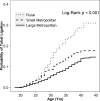Urban-Rural Differences in Tubal Ligation Incidence in the State of Georgia, USA
- PMID: 28731204
- PMCID: PMC5776071
- DOI: 10.1111/jrh.12259
Urban-Rural Differences in Tubal Ligation Incidence in the State of Georgia, USA
Abstract
Purpose: To evaluate the difference in tubal ligation use between rural and urban counties in the state of Georgia, USA.
Methods: The study population included 2,160 women aged 22-45. All participants completed a detailed interview on their reproductive histories. County of residence was categorized using the National Center for Health Statistics Urban-Rural Classification Scheme. We estimated the association between urbanization of county of residence and tubal ligation using Cox regression. Among women with a tubal ligation, we examined factors associated with prior contraception use and the desire for more children.
Findings: After adjustment for covariates, women residing in rural counties had twice the incidence rate of tubal ligation compared with women in large metropolitan counties (adjusted hazard ratio [aHR] = 2.0, 95% CI = 1.4-2.9) and were on average 3 years younger at the time of the procedure. No differences were observed between small metropolitan and large metropolitan counties (aHR = 1.1, CI = 0.9-1.5). Our data suggest that women from large metropolitan counties are slightly more likely than women from rural counties to use hormonal contraception or long-acting reversible contraception prior to tubal ligation and to desire more children after tubal ligation.
Conclusions: Women from rural counties are more likely to undergo a tubal ligation than their urban counterparts. Our results suggest that circumstances regarding opting for tubal ligation may differ between urban and rural areas, and recommendations of alternative contraceptive options may need to be tailored differently for rural areas.
Keywords: access to care; epidemiology; health disparities; observational data; tubal ligation.
© 2017 National Rural Health Association.
Conflict of interest statement
Figures
References
-
- United Health Center for Health Reform & Modernization. Modernizing Rural Health Care: Coverage, quality, and innovation. Minnetonka, Minnesota: United Health Center for Health Reform & Modernization; 2011.
-
- van Dis J. MSJAMA. Where we live: health care in rural vs urban America. Jama. 2002 Jan;287(1):108. - PubMed
-
- American College of Obstetricians and Gynecologists. [Accessed 01/24/2014];socioeconomic survey of ACOG fellows. 2008 :384–388. Available at http://www.acog.org/departments/dept_notice.cfm?recno=19&bulletin=5099.
-
- Peterson HB. Sterilization. Obstet Gynecol. 2008 Jan;111(1):189–203. - PubMed
-
- Chan LM, Westhoff CL. Tubal sterilization trends in the United States. Fertil Steril. 2010 Jun;94(1):1–6. - PubMed
Publication types
MeSH terms
Grants and funding
LinkOut - more resources
Full Text Sources
Other Literature Sources
Medical


